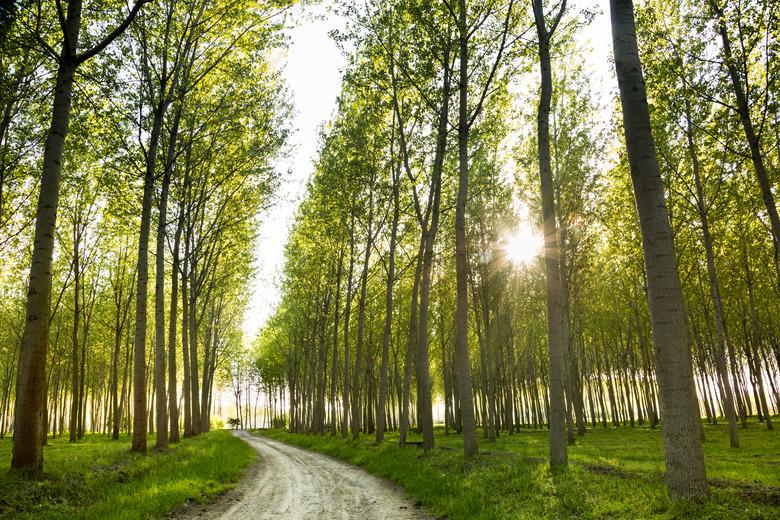The Lifespan Of A Poplar Tree
Poplar trees (Populus spp.) are a common American native tree. They're easy to grow, grow quickly and provide lots of shade. The species most people plant tend to live up to 50 years, so if you plant a poplar tree, you'll likely have moved by the time it needs to be replaced. But as trees go, they're short-lived.
Longevity of Poplars
Poplars live relatively short lives. Eastern cottonwood (Populus deltoides, USDA zones 2-9), also called Eastern poplar, aspen (Populus tremuloides, zones 1-6), and black poplars (Populus nigra, zones 2-10), also called Lombardy poplars, which grow wild, tend to live no more than 20 years. These poplars are susceptible to insect and disease problems like canker disease.
Hybrid poplars are the types you'll probably see at the garden center. These tend to live longer, maybe 50 years. They're good trees to plant in areas where you have a lot of room, need shade and want a fast-growing tree. Poplars are in the willow family (Salicaceae), and like willow trees, they typically live in wetlands or where water is plentiful.
Hybrid Poplar Tree
There are many types of hybrid poplar trees, but one of the most common is the cross between the Eastern cottonwood, an American native tree, and the black poplar, a tree native to Europe and North Africa.
These trees can grow to 20 feet in five years. There are types that thrive in various soil types, as well. These trees may not live as long as an oak (Quercus spp.) or maple (Acer spp.), but they thrive in areas that are disturbed or subject to polluted soil and chemical runoff.
Eventually, these trees reach 40 to 60 feet tall, with a spread of 20 to 35 feet. Poplar roots tend to be shallow, so you should plant them well away from your house or any outbuildings. You can expect these trees to live 30 to 50 years.
Lombardy Poplar Tree
These are very short-lived, native poplars that live about 15 years. They tend to spread through ground suckers, so they do best in an area with lots of room. They make good privacy or windscreens.
Tulip Poplar Tree
A tulip poplar tree isn't a true poplar. Tulip poplars (Liriodendron tulipifera, zones 4-9) are actually related to magnolia trees (Magnoliaceae family). These native American hardwood trees can be found in many wooded areas of the East and Midwest. Kentucky, Indiana and Tennessee have declared the tulip poplar the state tree.
Tulip poplars aren't related to tulips, either, although they do produce a spring flower that resembles its namesake. In cultivation, they grow 70 to 90 feet with a spread of 35 to 50 feet.
In ideal situations, tulip poplars live to be 250 years old, so these trees are very long-lived. Some tulip poplars have survived 400 years.
Balsam Poplar Tree
Native balsam poplars (Populus balsamifera, zones 5-9) are long-lived for poplars, typically surviving 100 years and sometimes up to 150 years. These tall, straight trees are one of the northernmost hardwoods in North America. They grow throughout much of Canada and the northern half of the United States.
Quaking Aspen Trees
This type of poplar, the aspen tree, has a whitish bark. Aspen trees grow straight, but the slender trunk rarely grows to more than 18 inches in diameter. These trees typically live no more than 150 years, although some aspens have been known to survive 200 years.
Aspen trees grow well in disturbed sites where there's bare soil. They can be found on slopes of sandy or gravelly soil, and they like the sun. In the Rocky Mountains, aspen trees are commonly seen in areas where there have been wildfires.
Known as quaking aspens because of their shimmering appearance as the wind blows through their crowns, the aspen tree is North America's most widely distributed tree. Aspens have spread through most of the West, upper Midwest and the Northeast to as far south as North Carolina.
Commercial Uses for Poplars
Poplars are commercial trees, and many are planted to harvest for wood, pulp, paper and other commercial purposes. While some types have wood that's too soft for many commercial uses other than pulp or paper, others, like the tulip poplar, are used as lumber. Native Americans often used tulip poplars to make canoes.
Balsam poplar bud resin was traditionally used in cough medicines and as an antiseptic.
References
- Arbor Day Foundation: Hybrid Poplar: The People's Tree
- University of Kentucky Department of Horticulture: Tulip Poplar
- Virginia Big Trees: Lifespan of Common Trees in Virginia
- Lady Bird Johnson Wildflower Center Plant Database: Populus Balsamifera
- USDA Forest Service: How Aspens Grow
- The Tree Center: Your Guide to Poplar Trees
